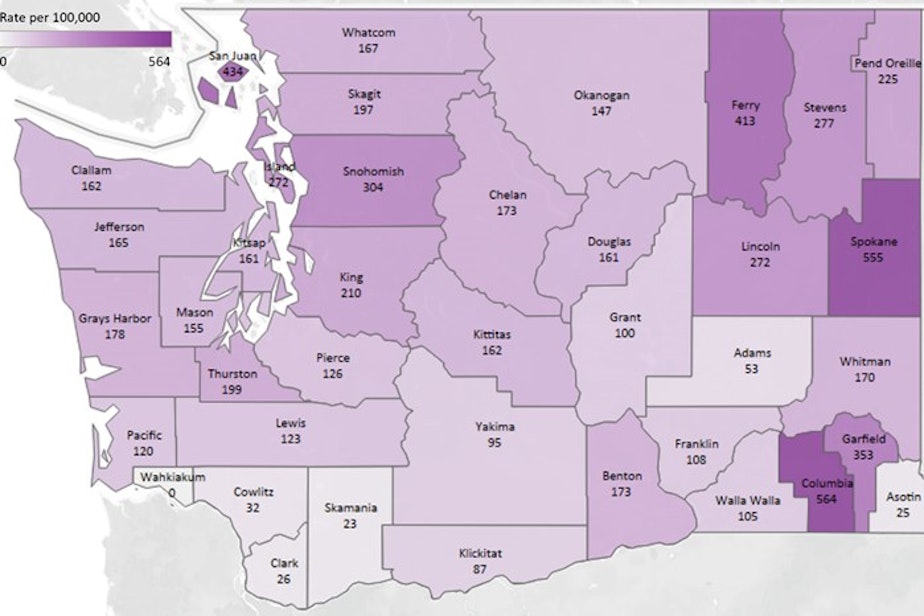Health expert recommends better listening and connection to confront rise in youth suicides

Recent studies show a rise in the number of children attempting to take their own lives. The Washington Poison Center reports cases of self-harm or suspected suicide rose 37% in adolescents from 2019 to 2021. That number jumped 58% in patients between the ages of 6 and 12. For many parents of children who attempt suicide there's a common refrain — they didn't see the signs.
KUOW’s Kim Malcolm talked to Dr. Kira Mauseth, co-lead of the Behavioral Health Strike Team at Washington's Department of Health, about why this is happening, and how to address it.
This interview has been edited for clarity.
Kim Malcolm: How big is this recent upward trend in suicide attempts, and do we know what's causing it?
Dr. Kira Mauseth: We're faced with a significant increase in risk and numbers. It's something that parents and caregivers alike need to be aware of. We can work as community members to help support our youth right now, who are really going through a hard time.
There are multi-layers of effects. As children have grown up in the era of technology, just having it readily available and accessible to them, there is more and more dependence to use external devices as coping mechanisms. But when we look at the emotion regulation for kids specifically, there really needs to be a sense of helping kids learn how to manage distressing experiences and emotions on that interpersonal level, without always having to rely on an external device.
Then add in the isolation from the pandemic and the impact of that over the last couple of years.
The passage of time flows differently for kids. It can seem like a lifetime that they've experienced this pandemic. Adults have a different perspective on that. Learning what it really looks like to transition from elementary school into middle school, without having the opportunity to watch those social transitions in person, has had this extra layer of impact on youth. They feel kind of lost and kind of distressed about not knowing what their anchors are and feeling really untethered around their own sense of social interaction with other kids.
Is this recent jump in suicide attempts impacting boys and girls equally?
Not really. There are higher risks right now associated with being an adolescent female than with other demographic groups. There are different sorts of emotional taxes and complications with social dynamics for young girls. It's a combination of underlying factors, as well as comfort with expression and cultural and social acceptance of that expression for girls.
What are the warning signs that parents and family members should be looking for?
One of the most basic things is a change from baseline behavior. I really want to encourage parents and caregivers to start to normalize a culture around checking in regularly and asking open-ended questions. I know kids talk a lot, but parents don't often listen from an active perspective. We really need to engage in a pattern of communication with our kids that's more open. The intention and the purpose of that communication is to understand their experience, rather than to fix something for them or to solve a problem.
Sponsored
That way, when there are risks that pop up, which are either gradual over time that you're able to see, or extreme changes of behavior, it's really clear that something's different, and something's amiss, and that you might need to get some professional help. Establishing that norm is key.
And if your kids just shut you down, or walk away, what then?
The key there is to not give up. One of the big issues that I've learned in working with teenagers in private practice is that they are going to communicate on their own schedule. They're going to do it at times that are sometimes very inconvenient for us. We need to make sure that even if it is 11:30 on a Wednesday night, or a text message in the middle of the night, that we try to be as receptive as we possibly can be, even when the time around the communication might not be convenient for us because when they are able and ready to communicate, we need to be ready to receive it. We need to have that door open for them.
For people concerned about themselves or a family member, what would you say are the first steps to keep in mind?
It's really easy to get overwhelmed right now with all of the things that we can't control. I would advise adults and teenagers, young adults alike, to try to focus your attention on something that you actually can be empowered to do. Whether that's making a good choice for yourself, making a healthier choice, doing something that you know is going to make you feel better that's not going to have a bigger long-term consequence, reaching out and helping someone else in need. It's amazing the extent to which, when we show compassion to others, that lifts our spirits as well.
Sponsored
Listen to the interview by clicking the play button above.
Washington Department of Health links Dr. Mauseth recommends:
Guidance document for youth in crisis (for pediatricians, but could be for anyone as well)





